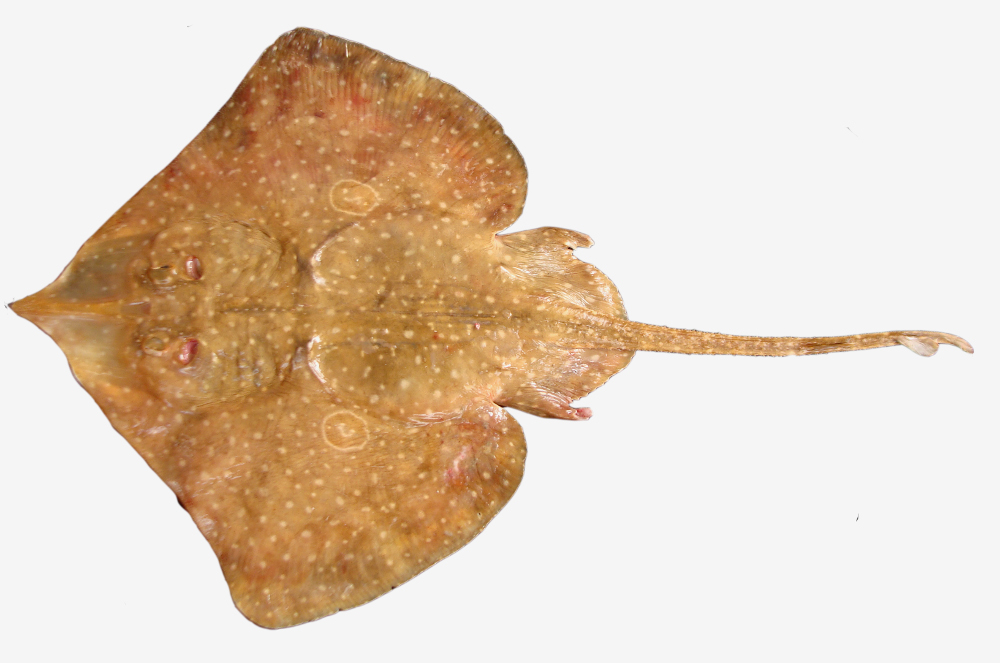Orbiraja powelli
(Alcock, 1898)
Indian ringed skate
Classification: Elasmobranchii Rajiformes Rajidae
Reference of the original description
A note on the deep-sea fishes, with descriptions of some new genera and species, including another probably vivparous Ophidioid. Annals and Magazine of Natural History, (Series 7), 2, 136–156
A note on the deep-sea fishes, with descriptions of some new genera and species, including another probably vivparous Ophidioid. Annals and Magazine of Natural History, (Series 7), 2, 136–156
Image of the original description
No image in first description.
No image in first description.
Synonyms / new combinations and misspellings
Okamejei cf. powelli, Okamejei powelli, Orbiraja cf. powelli, Raia powelli, Raja powelli, Raja powellii, Raja (Okamejei) powelli
Okamejei cf. powelli, Okamejei powelli, Orbiraja cf. powelli, Raia powelli, Raja powelli, Raja powellii, Raja (Okamejei) powelli
Description :
Citation: Orbiraja powelli (Alcock, 1898): In: Database of modern sharks, rays and chimaeras, www.shark-references.com, World Wide Web electronic publication, Version 01/2026
Please send your images of "Orbiraja powelli" to info@shark-references.com

Orbiraja powelli (Alcock, 1898), female, TL 42 cm, Muttom, Tamilnadu, India, 07.01.2017, coll. and © Bhagyalekshmi Venugopal, Department of Aquatic Biology and Fisheries, University of Kerala

Orbiraja powelli (Alcock, 1898), female, TL 42 cm, Muttom, Tamilnadu, India, 07.01.2017, coll. and © Bhagyalekshmi Venugopal, Department of Aquatic Biology and Fisheries, University of Kerala
Common names
 Indian ringed skate
Indian ringed skate
 Indian ringed skate
Indian ringed skate
Short Description
Original description of ALCOCK, 1898 [9955]: Near R. Murrayi, Gthr., but has a more produced snout and, sex for sex, is much smoother. The preoral portion is a little more than a third the entire length of the disk, and ends in a projecting snout, the length of which beyond the nostrils is somewhat more than the distance between the outer angles of the latter. The antero-lateral margins of the disk, from the snout to the rounded pectoral angles, are broadly sinuous. The width of the interorbital space is hardly more than the length of the orbit. There are several spines on the anterior edge of the orbit and one near its posterior angle, and there are numerous little spicules on the dorsal surface of the snout, as well as on parts of both the dorsal and ventral surfaces of the anterolateral margin. There is a row of three large spines on the middle line of the nape, and there are at least two rows of smaller spines on the posterior fourth of the disk, in the middle line. The tail is as long as the disk and is armed, both on the dorsal surface and on the sides, with rows of spines, those on the sides being smaller and more numerous than those on the dorsum. The caudal fin, which is present on the dorsal surface only, is confluent with the second dorsal. The teeth form a pavement; in the female in the upper jaw they are indistinctly tricuspid (the lateral cusps very small and blunt;, in the lower jaw they are more distinctly tricuspid. Colours: upper surface warm brown, with a pair of large, light-centred, light-edged, chocolate ocelli near the middle of the back.
Original description of ALCOCK, 1898 [9955]: Near R. Murrayi, Gthr., but has a more produced snout and, sex for sex, is much smoother. The preoral portion is a little more than a third the entire length of the disk, and ends in a projecting snout, the length of which beyond the nostrils is somewhat more than the distance between the outer angles of the latter. The antero-lateral margins of the disk, from the snout to the rounded pectoral angles, are broadly sinuous. The width of the interorbital space is hardly more than the length of the orbit. There are several spines on the anterior edge of the orbit and one near its posterior angle, and there are numerous little spicules on the dorsal surface of the snout, as well as on parts of both the dorsal and ventral surfaces of the anterolateral margin. There is a row of three large spines on the middle line of the nape, and there are at least two rows of smaller spines on the posterior fourth of the disk, in the middle line. The tail is as long as the disk and is armed, both on the dorsal surface and on the sides, with rows of spines, those on the sides being smaller and more numerous than those on the dorsum. The caudal fin, which is present on the dorsal surface only, is confluent with the second dorsal. The teeth form a pavement; in the female in the upper jaw they are indistinctly tricuspid (the lateral cusps very small and blunt;, in the lower jaw they are more distinctly tricuspid. Colours: upper surface warm brown, with a pair of large, light-centred, light-edged, chocolate ocelli near the middle of the back.
Distribution
Indian Ocean: Gulf of Aden; Travancore coast, India; and Gulf of Martaban. Source: www.gbif.org
Indian Ocean: Gulf of Aden; Travancore coast, India; and Gulf of Martaban. Source: www.gbif.org
Human uses
fisheries:
fisheries:
Size / Weight / Age
21.0 cm WD (male/unsexed; ); 22 cm WD (female)
21.0 cm WD (male/unsexed; ); 22 cm WD (female)
Habitat
demersal; marine; depth range 122 - 244 m
demersal; marine; depth range 122 - 244 m
Remarks
shark-references Species-ID=14792;
shark-references Species-ID=14792;
















